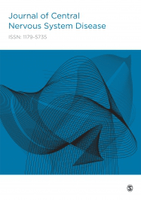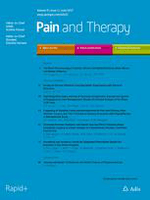
CNS DRUGS
Scope & Guideline
Elevating Clinical Practices with Groundbreaking Research
Introduction
Aims and Scopes
- Pharmacological Treatments for CNS Disorders:
The journal publishes research on the pharmacological management of various CNS disorders, including epilepsy, depression, schizophrenia, multiple sclerosis, and neurodegenerative diseases. This includes both established medications and emerging therapeutic strategies. - Clinical Trials and Real-World Evidence:
CNS Drugs emphasizes the importance of clinical trials and real-world evidence in understanding the effectiveness and safety of CNS drugs. Many papers discuss trial results, observational studies, and meta-analyses to inform clinical practice. - Mechanisms of Action and Drug Development:
The journal explores the underlying mechanisms of action of CNS drugs, contributing to the understanding of how these drugs affect neurological and psychiatric functions and guiding the development of novel therapies. - Patient-Centric Approaches and Outcomes:
Research focusing on patient outcomes, quality of life, and the tolerability of treatments is a core area, addressing how pharmacological therapies impact patients' daily lives. - Emerging Therapies and Innovations:
CNS Drugs highlights innovative therapies, including new drug formulations, combination therapies, and the use of biologics, reflecting the journal's commitment to advancing treatment options in the field.
Trending and Emerging
- Psychedelic-Assisted Therapies:
The exploration of psychedelic drugs for therapeutic use in treating various mental health disorders has gained traction, highlighting a renewed interest in these compounds and their potential benefits. - Combination Therapies:
There is an increasing emphasis on combination therapies, particularly in the treatment of conditions like Alzheimer's disease and depression, reflecting a trend towards more comprehensive management strategies. - Biologics and Targeted Therapies:
The rise of biologic therapies and targeted treatments for conditions such as multiple sclerosis and neurodegenerative diseases indicates a paradigm shift in how these disorders are treated. - Patient-Centric Research:
A growing focus on patient perspectives, outcomes, and quality of life in clinical research reflects an increasing awareness of the importance of patient-centric approaches in CNS drug development. - Real-World Evidence and Data Utilization:
The use of real-world evidence in understanding treatment effectiveness and safety is becoming more prominent, emphasizing the need for data that reflects everyday clinical practice.
Declining or Waning
- Traditional Antiseizure Medications:
Research focused on older antiseizure medications has become less prominent, likely due to the emergence of newer drugs with improved efficacy and safety profiles. The shift signifies a move towards investigating novel therapies rather than re-evaluating established treatments. - Single-Agent Psychiatric Treatments:
There is a noticeable decline in studies exclusively evaluating single-agent treatments for psychiatric disorders, as the focus has shifted towards combination therapies and personalized medicine approaches. - Long-Term Side Effects of Established Treatments:
Although important, studies specifically addressing long-term side effects of traditional treatments are appearing less frequently, possibly due to a growing emphasis on efficacy and immediate clinical outcomes. - Pharmacological Management of Rare CNS Disorders:
Research on pharmacological treatments for rare CNS conditions has decreased, possibly due to the limited patient populations and funding opportunities, leading to a focus on more common conditions. - Neuropharmacology of Older Drug Classes:
Topics related to the neuropharmacology of older drug classes, such as first-generation antipsychotics, are seeing reduced attention as the field progresses towards newer medications with novel mechanisms of action.
Similar Journals

ACTA NEUROLOGICA BELGICA
Elevating Clinical Practice Through Rigorous Research.ACTA NEUROLOGICA BELGICA is a leading academic journal published by Springer Heidelberg, dedicated to advancing the field of neurology and medicine. With an ISSN of 0300-9009 and E-ISSN 2240-2993, this journal has been a vital resource since its inception, contributing significantly to neurological research and clinical practice. It holds a respectable impact factor with categories spanning from Q2 in Medicine (miscellaneous) to Q3 in Neurology (clinical) as of 2023, indicating its prominence in the scientific community. The journal's extensive coverage since 1959 enhances its historical relevance, while its ongoing publication until 2024 ensures the latest developments are readily accessible. Researchers and practitioners can benefit from its rigorous peer-reviewed articles, which are crucial for staying current in this rapidly evolving discipline. As a scholarly platform, ACTA NEUROLOGICA BELGICA plays a pivotal role in disseminating knowledge and fostering innovation in neurology, making it a must-read for professionals, students, and anyone involved in the field.

Therapeutic Advances in Neurological Disorders
Connecting researchers and practitioners in the realm of neurology.Therapeutic Advances in Neurological Disorders, published by SAGE Publications Ltd, is a leading open access journal dedicated to the advancement of knowledge in the field of neurology. Since its inception in 2008, this journal has established itself as a vital resource for researchers, healthcare professionals, and students, offering a platform for the dissemination of high-quality research that improves the understanding and treatment of neurological disorders. With a commendable impact factor and ranked Q1 in multiple categories, including Neurology and Pharmacology for 2023, it exemplifies excellence in scholarly contributions. The journal's Scope encompasses a wide array of topics, providing insights that are pivotal for clinical practice and pharmacological development. Additionally, with its commitment to open access since 2017, Therapeutic Advances in Neurological Disorders ensures that its research reaches a global audience, fostering collaboration and innovation in neurological science.

ANTI-CANCER DRUGS
Innovating Strategies in Anti-Cancer ResearchANTI-CANCER DRUGS is a leading journal in the domain of cancer research and pharmacology, published by Lippincott Williams & Wilkins. With its inception dating back to 1990 and ongoing publication through 2024, this journal serves as a vital resource for researchers, clinicians, and students interested in the latest advancements and discoveries in cancer therapeutics. Although classified in the Q3 quartile across relevant categories such as Cancer Research and Oncology, its growing impact is evidenced by its competitive Scopus rankings, positioned within the 30th to 52nd percentiles across various disciplines. The journal remains committed to promoting innovative research that can translate into effective anti-cancer strategies, providing valuable insights into drug development and applications. While it does not currently offer open access, the journal continues to attract a sophisticated readership, making it an essential platform for disseminating significant findings in the ever-evolving field of oncology.

Therapeutic Advances in Psychopharmacology
Driving Progress in Psychopharmacological ResearchTherapeutic Advances in Psychopharmacology is a leading open-access journal published by SAGE Publications Ltd, focusing on the dynamic integration of pharmacological therapies and psychological health. Since its inception in 2011, this journal has made a significant impact on the fields of pharmacology and psychiatry, consistently earning a Q1 ranking in both categories as of 2023, reflecting its esteemed position within the scientific community. With an impressive Scopus rank placing it in the top 15% across relevant disciplines, the journal serves as a vital platform for researchers, professionals, and students eager to explore cutting-edge advancements in psychopharmacology. The open-access model, established in 2019, ensures that groundbreaking research is accessible to a wide audience, fostering collaboration and innovation in therapeutic strategies for mental health disorders. Through the dissemination of high-quality research and reviews, Therapeutic Advances in Psychopharmacology is committed to advancing understanding and practice within this critical field.

CURRENT THERAPEUTIC RESEARCH-CLINICAL AND EXPERIMENTAL
Bridging laboratory research and clinical application for impactful outcomes.CURRENT THERAPEUTIC RESEARCH-CLINICAL AND EXPERIMENTAL is a pivotal open-access journal published by Elsevier Science Inc., dedicated to the advancing field of clinical and experimental pharmacology. Established in 1959, this esteemed journal is committed to providing a platform for the dissemination of innovative research findings that span the entire spectrum of therapeutic sciences. With an impact factor that reflects its focus on enhancing medical knowledge and practice, CURRENT THERAPEUTIC RESEARCH serves a diverse audience of researchers, healthcare professionals, and students, striving to bridge the gap between laboratory research and clinical application. The journal has achieved a Q3 ranking in both the pharmacology and medical pharmacology categories, signifying its contribution to the field. With its open-access model initiated in 2006, it underscores the importance of research accessibility, ensuring that valuable insights reach a global audience. As the journal continues to evolve, it remains an essential resource for those devoted to improving therapeutic interventions and advancing healthcare outcomes through rigorous scientific inquiry.

Current Neuropharmacology
Pioneering insights in brain health and pharmacology.Current Neuropharmacology is a premier journal dedicated to advancing the field of neuropharmacology, published by Bentham Science Publishers Ltd in the United Arab Emirates. As a leader in its domain, this journal has achieved a remarkable position in 2023, with Q1 rankings across several categories including Medicine (miscellaneous), Neurology, and Pharmacology. With a robust focus on the latest research related to pharmacological treatments and their neurological implications, Current Neuropharmacology features cutting-edge studies that inform clinical practices and psychiatric care. Although not open access, the journal offers both print and electronic formats to cater to a diverse audience of researchers, healthcare professionals, and students keen on accessing vital information in neuropharmacology. Its high impact within the academia is underscored by impressive Scopus rankings, confirming its importance as a vital resource for the ongoing exploration of mental health and neurotherapeutic innovations. With an engaging scope that encompasses emerging discoveries and clinical advancements, Current Neuropharmacology continues to be an essential platform for scholarly communication in the evolving landscape of neuroscience and pharmacology.

Journal of Central Nervous System Disease
Illuminating the path to neurological understanding.Welcome to the Journal of Central Nervous System Disease, a premier Open Access publication dedicated to advancing the understanding of neurological disorders and their underlying mechanisms. Published by SAGE Publications Ltd, this esteemed journal has been serving the scientific community since 2009 and is committed to disseminating high-quality research that spans from clinical neurology to cellular and molecular neuroscience. With an impressive impact factor, the journal ranks within the top quartiles—Q2 in both Neurology and Clinical Neurology, and Q3 in Cellular and Molecular Neuroscience as of 2023. The journal's indexing in Scopus reflects its significant contribution to the field, being ranked #83 out of 400 in clinical neurology and #38 out of 97 in cellular and molecular neuroscience. This essential resource, based in the United States, is crucial for researchers, clinicians, and students looking to stay at the forefront of neurological science. By providing Open Access options, we ensure that groundbreaking research is readily available to a global audience, fostering collaboration and innovation in the study of central nervous system diseases.

SCIENTIA PHARMACEUTICA
Innovating the future of pharmacology and toxicology.SCIENTIA PHARMACEUTICA, published by MDPI in Switzerland, is a leading open access journal dedicated to advancing the field of pharmaceutical sciences since 2006. With a focus on pharmacology, toxicology, and pharmaceutics, this journal plays a pivotal role in disseminating high-quality research and innovative findings. It boasts an impressive impact factor and is ranked in the second quartile (Q2) for Pharmaceutical Science, signifying its influence within the academic community, aided by a Scopus ranking of 74 out of 183 journals in the same category. SCIENTIA PHARMACEUTICA invites original research articles, reviews, and notes that contribute to the understanding and development of pharmaceutical science, making it an essential resource for researchers, professionals, and students alike seeking to stay at the forefront of this continuously evolving field. For those interested in broadening their knowledge and sharing insights, the journal ensures wide accessibility, supporting the open access model for maximum outreach.

Pain and Therapy
Exploring Innovative Solutions for Pain Relief.Pain and Therapy is a prestigious, peer-reviewed journal published by SPRINGER INTERNATIONAL PUBLISHING AG that has been a beacon of research in the field of pain management and neurology since its inception in 2012. With an ISSN of 2193-8237 and an E-ISSN of 2193-651X, this open access journal facilitates the dissemination of high-quality research to a global audience. Recognized within the top Q1 quartile for Anesthesiology and Pain Medicine, and the Q2 category for Clinical Neurology, it ranks impressively within the Scopus indexing, positioned at #20/136 in its primary category, demonstrating an 85th percentile standing. The journal's commitment to open access enhances its impact, allowing researchers, clinicians, and students to explore and contribute to critical developments in pain therapy and management. The convergence of cutting-edge research and innovative therapeutic strategies makes Pain and Therapy an essential resource for anyone dedicated to advancing knowledge in this vital field.

JOURNAL OF PSYCHOPHARMACOLOGY
Elevating the Discourse on Mental Health InterventionsJOURNAL OF PSYCHOPHARMACOLOGY, published by SAGE Publications Ltd, is a leading peer-reviewed journal that explores the intricate dynamics of pharmacological interventions in mental health and psychiatry. With an ISSN of 0269-8811 and an E-ISSN of 1461-7285, this esteemed journal has established its reputation in the field since its inception in 1987, converging research excellence into 2024. Recognized as a Q1 journal in various categories including Medicine (miscellaneous), Pharmacology, and Psychiatry and Mental Health, it ranks impressively within the top percentile in Scopus, standing at #64 out of 567 in Psychiatry and Mental Health, and #31 out of 272 in Medical Pharmacology. The journal serves as a vital resource for researchers, professionals, and students, providing insightful articles that advance the understanding of psychopharmacological effects and innovations. Although it does not offer open access, the journal's extensive research and impactful findings make it essential reading for anyone engaged in the field. For those seeking to stay at the forefront of psychopharmacology, the JOURNAL OF PSYCHOPHARMACOLOGY is an invaluable asset.